|
Monday, August 29, 2011
Progress Notes
In the Progress Notes of August 15, I presented the story of the Doerhoff Orchestra of St. Elizabeth, one of the area’s most popular musical groups in the late 1930’s up through the 1960’s. Dale Doerhoff, son of Leonard Doerhoff, who was one of the original members of this family musical group, also played with the band occasionally. He now is an attorney in Columbia (photo 01).
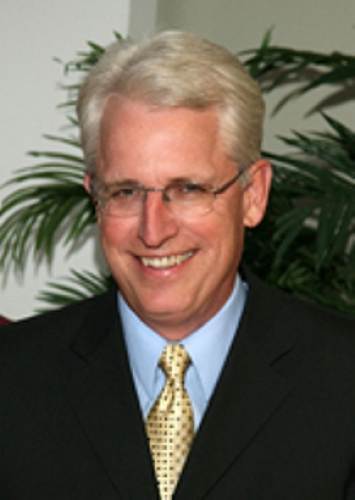
01 Dale Doerhoff
One of Dale’s interests through the years has been devoted to historical research regarding the community of St. Elizabeth and its German heritage. Dale has written a book featuring his historical research about the St. Elizabeth community titled “A Trip To Charleytown.” The name “Charleytown” originated from Westphalia native, Charles Holtschneider, who owned six thousand acres in the area and who donated the land where the present church and rectory now is located. Actually, the name first was spelled “Charlestown” but it is the diminutive of that name, “Charleytown,” most often used early on in the town’s history. Charlestown was incorporated as a village on May 24, 1948. It was not until June 5, 1961, that the town became officially St. Elizabeth when the change was approved by the Missouri Secretary of State.
In 2005 St. Elizabeth celebrated 125 years of history in Miller County. In honor of that milestone, Dale wrote a short history of St. Elizabeth for the Miller County Autogram Sentinel:
Celebrating 125 years of St. Elizabeth History
Dale Doerhoff
Miller County Autogram-Sentinel
October 6, 2005
The St. Elizabeth community of 2005 is rooted in the “St. Elizabeth Settlement,” a German Catholic settlement community that formed in the Jim Henry Township of northeastern Miller County in the second half of the 1860’s, immediately after the American Civil War. It was an offshoot of the Westphalia Settlement, a colony of immigrants from northwest Germany who migrated into Osage County in the 1830’s, 1840’s and 1850’s. With migration into the St. Elizabeth Settlement area and high birth rates among the families, the community grew quickly. It soon split into three towns: Charlestown (new St. Elizabeth), Mary’s Home and St. Anthony.
Owen Riggs, who along with his brother Calvin Riggs, left Tyler County, Virginia, in 1838 and came to Miller County, Missouri (photo 02).
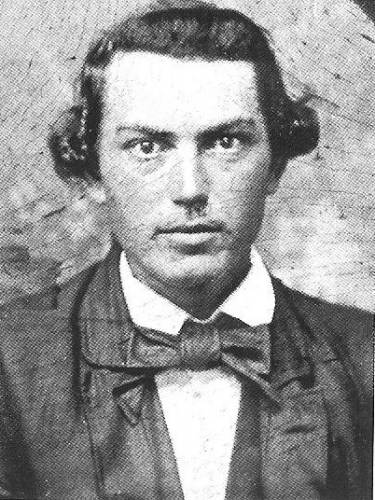
02 Owen Riggs, Founder of St. Elizabeth
Their first home was a log cabin in the Big Tavern valley, about two miles north of the present town of St. Elizabeth. The Riggs brothers apparently made money the “old fashioned way”…in 1845 they were charged with the first liquor law violation in Miller County. Owen Riggs was also a land speculator, buying land from the government to resell for a profit. At one time he owned nearly 6000 acres in northeast Miller County.
While the Riggs brothers were bootlegging and buying up land in Miller County, German immigrants were flowing into Missouri, starting in the 1830’s and growing into a flood of tens of thousands by the 1840’s and 1850’s. Osage County became the end of the pipeline for a series of “chain migrations” from what is now the state of Nordrhein-Westfalen in north west Germany. What began as the “Westphalia Settlement” in the Maries River valley in 1836 became the western end of a migration stream that lasted until the start of the American Civil War in 1860. In two and one half decades, many German immigrant families came to Central Missouri and radiated out from the Westphalia Settlement into areas where land was available for settlement.
In April 1869 Riggs filed a plat for a new town he named St. Elizabeth, on the southeast bank of the Osage River, less than a mile upriver from the mouth of the Big Tavern Creek. It seemed like a good location, because the fertile Osage and the Tavern bottoms presented excellent farming opportunities and the streams were the highways of commerce. When Riggs platted St. Elizabeth there were several German-American farm families already in the area, with more on the way from Westphalia, Koeltztown and St. Thomas.
By 1870, the year after Riggs platted St. Elizabeth, there were enough German Americans in the settlement to support the first Catholic parish in Miller County. Conrad Kemna hewed the logs for the framework of the new church building, which was 22 feet wide and 29 feet long. Among others who assisted in erecting the frame structure were Henry Heckemyer, Joseph Buechter, Henry Boedeker, George Borgmeyer, Henry Doerhoff and his brother Bernard Doerhoff, Andrew Schell, Patrick Whalen, Henry Leibert and Stephen Koester. Of the eleven men listed, seven were German born (Boedeker, Borgmeyer, Buechter, Henry and Bernard Doerhoff, Leibert and Koester), three were sons of German born immigrants (Heckemeyer, Kemna and Schell), and one was a native of Ireland (Whalen).
In spite of what appeared to be a promising beginning, the original town of St. Elizabeth soon withered and died on the vine. What happened? The town had three strikes against it. The first was the death of Owen Riggs. On October 5, 1875, he was robbed and murdered as he was riding back to St. Elizabeth from a cattle drive to Sedalia. His widow was left with too many children and not enough money, and Riggs’ holdings were lost in a series of foreclosures. One of those foreclosures was by a Westphalia couple, Charles and Regina Holtschneider, and it was on repossessed land that the Holtschenieders platted the town of Charlestown (later new St. Elizabeth) in 1880.
The second strike was the splitting of the St. Elizabeth parish in two: St. Lawrence parish at Charlestown in 1881 for the Catholics south and east of the Osage River, and in 1882 Our Lady of the Snows parish at Mary’s Home for the Catholics north and west of the river. The third and decisive strike against the original town of St. Elizabeth was that it was not a healthy place to live.
Note: Dale is referring here to the belief that numerous childhood diseases were caused by being too close to the river where dampness often was associated with early morning mist and fog. This information was given me by Dale’s mother, Cyrilla Tellman Doerhoff.
Leaders of the Old St. Elizabeth community were involved in establishing the new town on higher healthier ground owned by the Holtschneiders. The survey work was done by H.S. Burlingame, the Miller County Surveyor. When he came to the new town site in August 1880 nothing was there. For the point of beginning he set a flint stone, 12 x12 x10 inches in size, at the northwest corner of the “Church Lot.” The town lots, streets and alleys were laid out in reference to this foundation stone. Burlingame completed his fieldwork and drafted the plat on August 6, 1880.
As the new town was being planned, the postmaster, William Wetlock, made a request to the U.S. Post Office Department to change the name of the local post office from St. Elizabeth to St. Lawrence, the patron saint of the parish at the new town. The Post Office Department rejected this on the ground that it was too similar to the name of Lawenceton, Missouri. “Charles-Town” was the next choice, in homage to Charles Holtschneider, the owner and developer, and that name was written on the plat. But the Post Office Department would not allow the local post office to be changed to that name, either, because it was confusingly similar to Charleston, Missouri. So the post office name and official mailing address remained St. Elizabeth.
In spite of the initial delay over the name, as soon as the plat was filed on December 18, 1880, development took off. A deed from the Holtschneiders to Bishop Hogan of The Diocese of Kansas City for the Church Lot was recorded on December 18, 1880, the same day the plat was filed. During the next three years, the Holtschneiders sold town lots or a acreage to a number of German American settlers: Hermann Volmert, John Radamacher, Frank Evers, Joseph Wilde, William Luecke and Hermann Ortbals, William Luecke, Jr. After Charles Holtschneider died in 1883, his widow, Regina, continued to sell Charlestown property to the German Americans settling the area: Frank Bax, William Wetlock, and Joseph Wilde.
Three and half years after the surveyor set the witness stone and marked five acres of open land into a village of six blocks, reports from the new town of Charlestown (or Charleytown” as it was commonly referred to in everyday speech and sometimes in print), began appearing in the “Missouri Volksfreund,” a German language newspaper published in Jefferson City and widely read throughout the German American settlement region of Central Missouri. The news reports showed how much progress had been made in a relatively short time and how much promise there was for the future. “Charleytown” was the center of an area of several thousand acres populated by farm families. Farming was profitable in those days, especially in the fertile bottom lands of the Osage River and Big Tavern creek, and this economic prosperity, coupled with their industriousness, education and other progressive traits, enabled the “Charleytowners” to build a town where they could not only satisfy their needs for goods and services but also fulfill their religious aspirations and social desires.
Between 1884 and 1920 there were 460 letters from Charleytown/St. Elizabeth published in the “Missouri Volksfreund.” The letters were written in the German language, because that was the “mother tongue” of the people. Recently translated into English for the first time, they pull back the curtain of time and let the reader have a glimpse of what life was like in the formative days of the community. These translated letters were used to write “A Trip to Charleytown---The German American Community at St. Elizabeth, Missouri 1880-1920.” The book also draws on other original German language sources such as school texts and prayer books that were in everyday use in “Charleytown.,” which was a bilingual community.
Although their population in the locality may have been small, the pioneers of the St. Elizabeth Settlement were part of the greatest voluntary migration in human history. Between 1820 and 2000, seven million people immigrated to the United States from Germany, more than from any other nation.
The pioneers of the St. Elizabth Settlement were first and second generation immigrants from an area that is in the current German state (Land) of North Rhine-Westphaolia (Nordrhen-Westphaolia) with a majority of them tracing their roots to farming communities in and around the Warendorf district, east of the city of Munster.
There are 200 persons buried at St. Elizabeth who were born before 1869, the year the St. Elizabeth Settlement was founded at Old St. Elizabeth. Of these two hundred pioneers, 77 were born in Germany. There were Baxes from Delbruck; Bodes from Erkeln; Boeckmanns from Mantinghausen; Boedekers from Lipperode; Borgmeyers from Mastholte; Dickneites, Evers and Rehagens from Westerloh/Sudhagen; Hasenbeins from Paderborn; Huhmanns from Hoxter; Doerhoffs, Lueckenhoffs, Vossmers and Westermanns from Oelde; Koesters from Westenholz; Luetkemeyers from Schwaney; Massmans from Ovenhausen; Stuckenscheiders from Moese; and Schnzmeyers from Langenberg.
There were other immigrants from Westrfalen whose towns of origin were not identified in the immigration records.
In addition to the Westphalians, there were some Rhinelanders among the St. Elizabeth Settlement pioneers. There were Kliethermes from Krefeld, Koenigs from Osterath, Oligschlaegers from Koblenz, and Wankums from Lank. There were also a few immigrants from the adjoining Hannover and Wurttemberg regions.
The presence of 77 German born pioneers at St. Elizabeth does not mean it was settled directly by immigrants coming right off the boat. It was a second stage settlement, being an offshoot of the earlier Westphalia Settlement in Osage County. In all, 89 of the 200 pioneers (born before 1869) were born in Osage County to German immigrant parents. These included family names Bax, Baumhoer, Beutel, Bode, Boeckmann, Borgmeyer, Buechter, Busche, Dickneite, Doerhoff, Evers, Hake, Heckemeyer, Heimann, Holtmeyer,Huchtmeyer, Huhmann, Jurgensmeyer, Kemna, Lindenbusche, Luebbert, Lueckenhoff, Massmann, Oligschlaeger, Ortbals, Plassmeyer, Rehagen, Scheulen, Struemph, Twiehause, Verhoff, Weidinger, Westermann, Wilbers and Wilde.
The parents of the 89 second generation immigrants migrated from the same places as the 77 German born settlers. Together they made up 83 percent of the pioneers of the St. Elizabeth Settlement. Such a concentration of interrelated people created a tightly knit community.
Within Missouri there were distinct German American settlement regions, made up of clusters of towns, villages and farming neighborhoods interconnected by ties of blood, marriage, ancestry, religion, commerce, and language. One of those was the German American settlement region of Central Missouri, in Cole, Osage, Miller and Maries counties, with a few outposts beyond. Two dozen German Catholic parishes and nine German Lutheran congregations formed the base of this extended settlement community.
Nine exceptions to the two step process were the Luetkemeyers and Tappehorns, who immigrated directly to St. Elizabeth from Westfalen after the Civil War, and Joseph Beck, who came even later.
I have a collection of photos having to do with early St. Elizabeth gathered from several sources including ones I purchased at the old Schell Store in St. Elizabeth, ones given me by Dale’s mother, Cyrilla Doerhoff, Dale’s article in the Autogram presented above, and others from Dale’s book, “A Trip To Charleytown.” These photos, which are presented in no particular order, offer an interesting collage of images representative of the St. Elizabeth of a century or more ago (photos 03 - 42).
Click on any of the photo thumbnails to view a larger image.
Note: Once you click on an image below, a new window will open. It would be best to maximize this new window by clicking on the middle box in the upper right-hand corner of the window. When you move your cursor over the image in this new window, it will change to a magnifying glass. Once this occurs, click on the image and it will show in a larger format for easier viewing.
Photo 35 is of the church bell manufactured by the J.G. Stuckstede Company for the St. Lawrence Church. This is the same company which made the bell for the Presbyterian Church of Tuscumbia, which now is displayed in front of our museum in Tuscumbia.
In the collage of photos presented above were a number of the priests who served the St. Lawrence church. They were addressed by the name “Friar.” One of the most important of them was Cosmas Seeberger. Here is a photo of Cosmas Seeberger taken many years after the one of him in the collage above (photo 43):
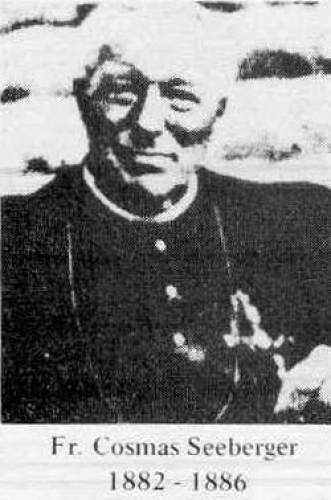
43 Father Robert Seeburger
Peggy Hake has written for our website an interesting essay about this most distinguished and important person who had great influence in the development of early St. Elizabeth as well as Mary’s Home:
FATHER COSMOS SEEBERGER
Peggy Hake
Between 1881 and 1887, Father Cosmos Seeberger was a Catholic priest in Miller County, serving both the parishes at St. Elizabeth and Mary's Home. His life, while in our central Missouri community, is one of great interest.
Father Cosmos was on his way to Miller County at the end of October, 1881 but was detained by high waters at Jefferson City. While in the city, he filled in at a jubilee celebration for a "festpridiger" who had failed to appear. Among his audience was Missouri's Secretary of State another man who was a close friend of Governor Criddenden. When they learned he was coming to Miller County, he was told if ever he needed help to contact them. Miller County had quite a reputation in those years!!
NOTE: Since I do not understand the German language, I don't know what or who a "festpridiger" was. If it was to be a jubilee celebration, it must have been an important event......"
One of the first things he had to contend with after arriving was bailing three young men out of trouble who had been selling beer without a license. Father Cosmos went to Jefferson City and pleaded the case for the 3 men whom he said were poor; the parish was in debt; the people were good folks at heart, etc...... The Governor informed him that the people of Miller County were known to be a 'bad lot'. The priest presented such a heart-rendering story that the Governor proclaimed the fines of the 3 men were "paid in full"..........
Father Cosmos found Miller County's citizens to be rough and hardy mountain folk and, at times, difficult to control. He was determined to fill their hearts with a deep and lasting faith and he was spunky enough to do just that! The new pastor was well-liked by his flock and they were amazed how the "limping priest" (he was handicapped from an old leg injury) could work so hard and untiringly. He first settled at Old St. Elizabeth where the county's first Catholic Church was established on the east bank of the Osage River. Other business places in the old town included a blacksmith shop, a Wagoner shop; combination post office and grocery store/saloon; and a club-room. He later moved to Charlestown (today's St. Elizabeth) which was a few miles southeast of the old settlement.
Later he moved west of the river to accommodate the people who lived in that western area of the county which numbered about 50 families. A new church, St. Mary of the Snows, was built where two roads crossed. A town was established around the church, first called Morgan, later renamed Mary's Home. Father Cosmos certainly had his work cut out for him...every Sunday he spent half the day at the St. Charles Church in Charlestown (later St. Elizabeth); forded the river and spent the remainder of the day at the Mary's Home church. He performed masses; also benedictions, and religious instructions at both churches.
St. Charles at Charlestown and St. Mary's at Marys Home continued to flourish, but Old St. Elizabeth gradually died away and the folks moved to Charlestown about 1881/82. Father Cosmos also performed masses on certain days at other places in the area....Gravois, Tuscumbia, Bond's Mines...... No matter what the weather, he always kept his appointments and there was a time he nearly drowned in the rushing flood waters of the Osage, but finally made it safely to the other shore.
Father Cosmos Seeberger was well-known throughout the entire county and was easily recognized as he passed through the heavily-wooded countryside. He rode a beautiful white horse and was often heard singing loudly as he ventured along in the darkness of the night. In 1887, Father Cosmos was recalled from Miller County. Many priests have served since he left the county over a hundred years ago, but none were so devoted nor so colorful as this Jesuit priest who left his footprints on the hearts of his many friends and fellow countrymen of German descent.
More information about Father Seeberger’s time in Mary’s Home is contained a book published by the parish at the time of the Centennial Celebration of Mary’s Home Parish:
The town of Mary’s home was originally to be given the name “Morgan” when, in the 1880’s, early settlers in the area were petitioning the government for a post office. Robert Morgan (photo 44), a local tavern proprietor and land owner, was honored by this suggestion, however Father Cosmas Seeberger, priest of the parish, was outraged at such an idea.
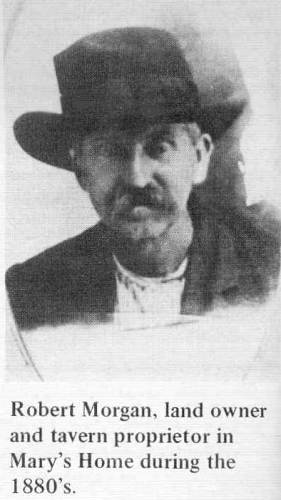
44 Robert Morgan
In his sermon Father Seeberger stated: “I founded this place; there was nothing here before I came. And now, without so much as a whisper to me, your pastor, you have taken this matter into your own hands and named this post office after a Protestant, a Yankee, a saloon keeper, while a founder of the place, I have the right to give it its name. This town belongs to the Mother of God, and its name shall not be “Morgan,” but “Mary’s Home.” What, do you imagine, does your mother think of this act of infidelity? See to it that this wrong is righted at once.”
Needless to say, the name on the petition was immediately changed and the town officially became known as Mary’s Home.
When Father Seeberger first ventured into Miller County in the early 1880’s, he found a rough, wooded region that was sparsely settled by people of predominantly German background. Few fields had been cleared and the roads were little more than muddy cow and mule paths. The early settlers that Father Seeberger encountered traveled solely by foot, by mule, or by boat on the Osage River.
Some of the early settlers in the area were John and Anna Wilburs, Henry and Elizabeth Schulte, Henry and Anna Eichholz, Charlie and Christine Frank, Henry and Theresa Evers, William and Helen Berendzen (photo 46), Franciscus and Sophia Lepper, John and Marie Hake, Anton and Margaret Lepper, August and Elizabeth Schulte, Herman and Mary Tellman (photo 47), John and Gertrude Mertens, John and Margaret Arens, and Mr. and Mrs. Bernard Roels.
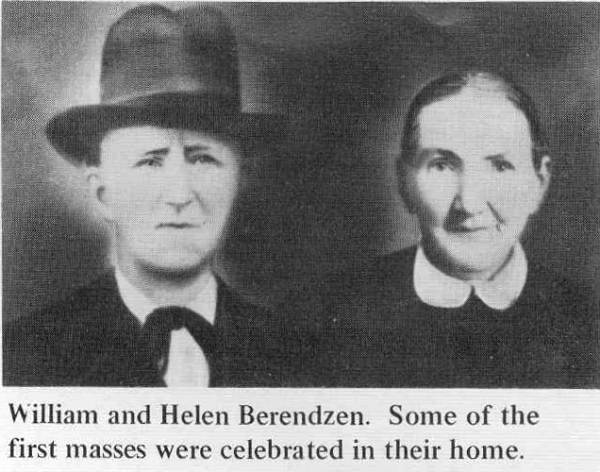
46 William and Helen Berendzen
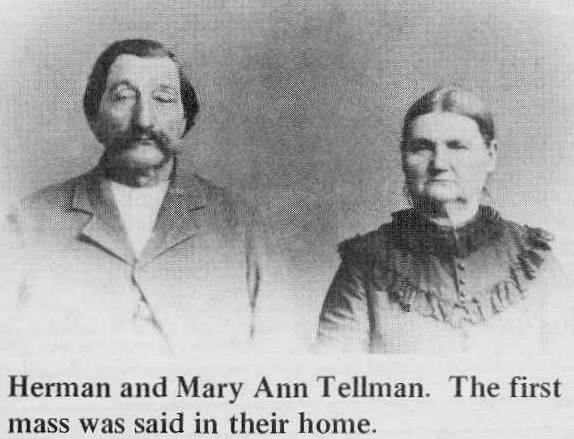
47 Herman and Mary Ann Tellman
The Osage River divided the existing “parish” into two parts. Father Seeberger would say mass at St. Elizabeth and the families west of the river would attend when possible. The location of the church in St. Elizabeth caused an inconvenience for those families, especially during times of flood. It was deemed necessary to establish a parish west of the Osage River in what is now the community of St. Mary’s Home. Father Seeberger was now busy travelling between St. Elizabeth and Mary’s Home to say mass. Although services were held in a church at St. Elizabeth, the members west of the river, as yet, had no church to call their own. For a little over two years Herman Tellman and William Berendzen volunteered the use of their homes for Father Seeberger to celebrate mass in (photo 48).
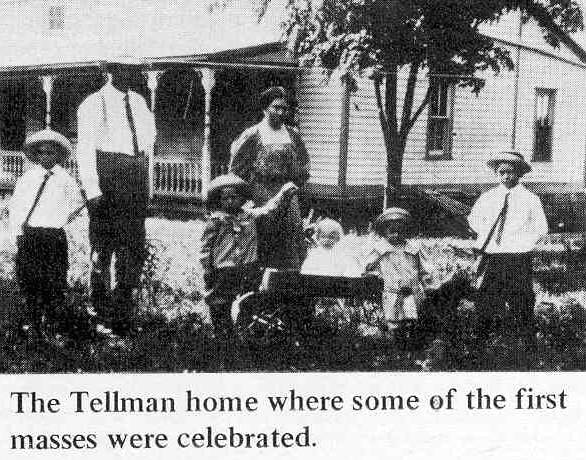
48 Tellman Home
Eventually Father Seeberger and his parishioners saw the need for a permanent church. A dispute then arose over where the new church would be located, each farmer demanding it be built close to his farm. When Father saw no happy end to the discussion, he chose a spot where two of the main roads in the area met.
On November 16, 1882, five acres of land were purchased by the parish from John and Nancy Henley for the amount of $30.00. Henry Schulte and Herman Tellman acted as trustees for the Mary’s Home church in this transaction. On two later occasions land was purchased in order to extend the parish grounds. On May 26, 1888, 1 ½ acres were purchased from Robert and Mary Morgan for the sum of $25.00. Trustees representing the Mary’s Home church were listed as J.H. Hake, Frank Sanning, Herman Bruening, and John Arens. Again, on January 29, 1889, Robert and Mary Morgan sold ½ acre of land to the church. This time the purchase was listed as $50.00.
On August 5, 1885, Bishop J. Hogan (photo 49) of Kansas City dedicated the first church in honor of St. Mary.
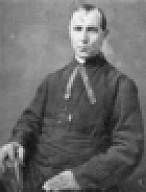
49 Bishop John Hogan
The original church was a 30’ X 30’ wood frame building erected at a cost of approximately $2000 (photo 50).
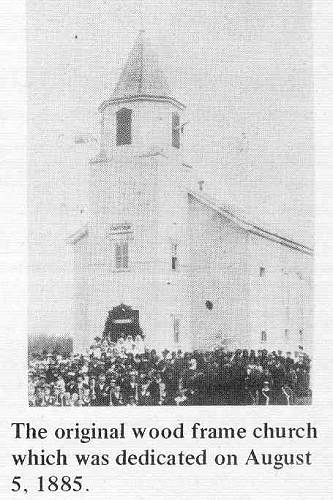
50 Original Wood Frame Church
The wooden floors and plastered walls were a result of hours of effort put forth by volunteers. Each parishioner was also responsible for providing wood for the pot bellied stove that supplied the heat for the church during the winter months (photo 51).
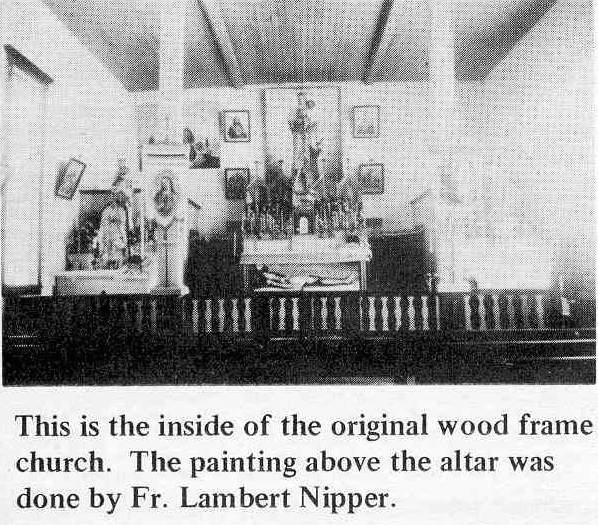
51 Inside of Original Wood Church
Apparently, the stove did not supply sufficient heat for the entire church. Sister Christine Wierschem and Sister Casimir Gawronski, of the Order of the Adorers of the Blood of Christ, recorded in their files that the stove sat in the middle of the church. Those who sat near it roasted on one side and froze on the other. It was sometimes so cold that the wine cruet had to be set near the stove until Offertory to keep the wine from freezing.
With the organization of the new parish came added duties for the priest. Father Seeberger’s schedule was so hectic that after two masses each Sunday, he many times was not able to eat his first meal until 4:00 p.m. Parishioners arriving early for mass were instructed to say the rosary and sing hymns until Father arrived.
With the new parish also came new citizens to Mary’s Home. This influx produced a need for merchants to provide necessary items to a growing community. Peter Kaullen, R.L. Morgan, and Martin Tremain were considered the “pioneer merchants.” Between 1886 and 1887, Peter Kaullen built a general store. Another general store/saloon was built and this store is today operated by Frieda Hart (Note: This store is no longer present) (photo 52 of Schulte’s General Store).
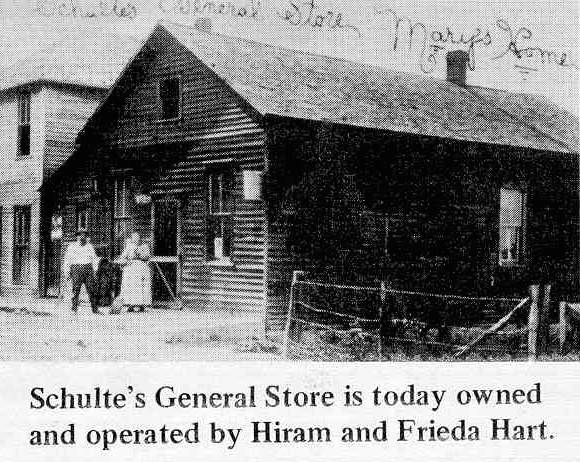
52 Schulte's General Store
Other businesses in Mary’s Home around this time included a lime kiln, a copper shop, a wagon shop, a blacksmith (photo 53), and a doctor’s office (photo 54).
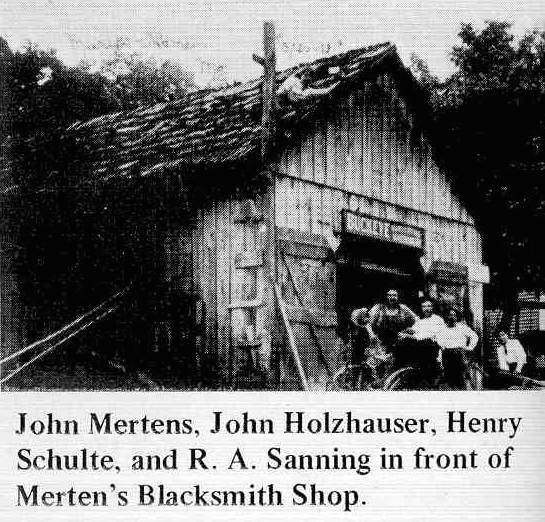
53 Mertens Blacksmith Shop
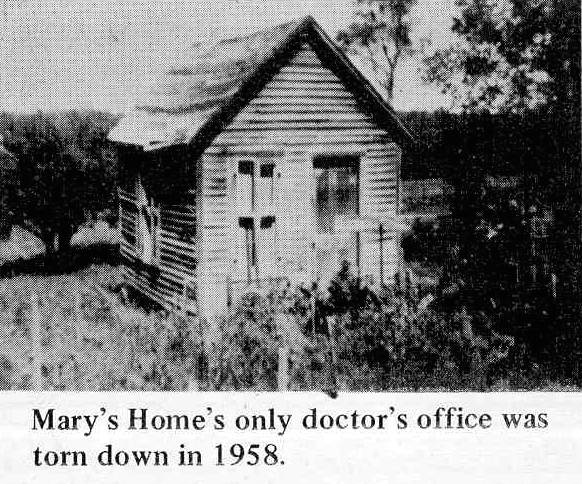
54 Doctor's Office
In 1886, Father Cosmas Seeberger was succeeded by Father Charles Meyer, CPPS, who was followed by Father Salser, CPPS, in 1887, Father Charles Meyer returned to Mary’s Home as the first resident pastor. It was probably during his two year stay that the first parochial residence was erected.
Here is a photo of the finished church at Mary’s Home (photo 55):
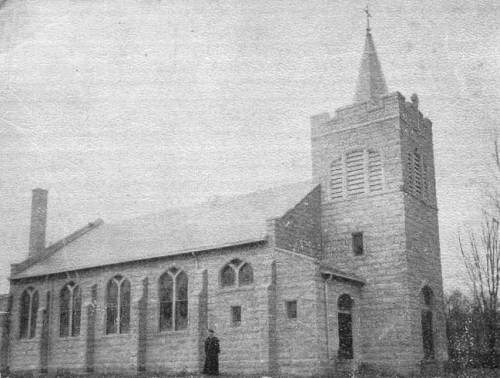
55 Mary's Home Church
We have had quite a few follow-up comments about the showing of the movie, “The Glory Brigade” last Sunday, August 17. Below is what Wallace Vernon (photo 56) wrote in the Advertiser about his memories of the making of the movie:
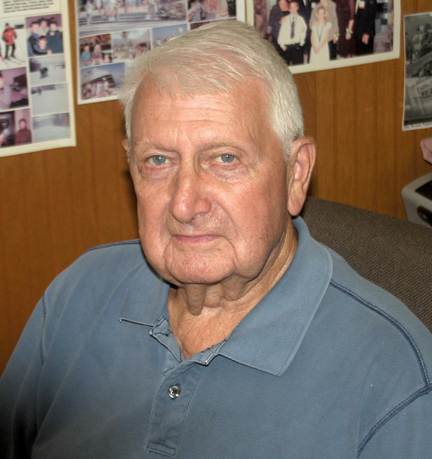
56 Wallace Vernon
WHO’D BELIEVE that fifty eight years could fly by so fast, but time slips up on you.
Notice of the showing of that 1953 film “Glory Brigade” at the Miller County Historical Society Museum last Sunday afternoon triggered the Ex Publisher’s recollection of the excitement that reached a fever pitch when actors Victor Mature, Lee Marvin, Roy Roberts and other favorites of the day could be seen at river’s edge down Tuscumbia way during the filming of the timely wartime movie.
Lee Marvin was one of the Ex Pub’s more favored stars of the era which brings to mind a coincidental encounter which came to light a year or so later when FW and EP were visiting former Advertiser/Autogram partner, Carl Winter, at his Tucson, Arizona, domicile.
The Winters purchased their Tucson ranchette from Marvin who built and initially occupied the upscale desert showplace.
A further recollect: Ex Pub wasn’t aware of it when the filming was accomplished, but every time one of the early Jesse James movies was shown at Eldon’s Ozark Theatre, the advertising and publicity releases featured the information that the exciting scene of horses jumping off those riverside cliffs was shot right here at the Lake of the Ozarks.
Let me tell you, Hollywood could find suitable sets for movies of an entirely different nature around our shorelines today including acres of watercraft anchored together to observe special aquatic events and magnificent condominiums and palatial lakeside mansions to rival fabled European spas and vacation retreats.
Time Marches on!
The Advertiser and the Autogram published a couple of photos related to the event. The first one taken by Ginny Duffield is of Orville Keeth from Iberia (photo 57):
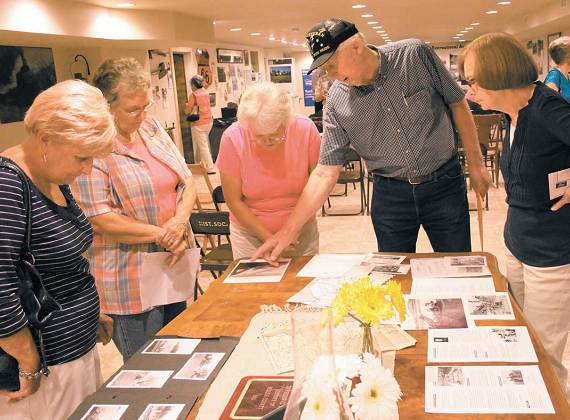
57
Orville Keeth of Iberia shows some photos from Korea, where he served with Company A,
14th Engineers of the U.S. Army in 1951. He was one of between 80 and 100 people who gathered
at the Miller County Historical Society Museum Sunday to view the move “Glory Brigade,”
which was shot near Tuscumbia and at Ft. Leonard Wood in the summer of 1952. A key scene
in the movie was blowing up a pontoon bridge which had been built across the Osage River.
Keeth had photos of such bridges he helped build in Korea.
(Photo by Ginny Duffield)
Another photo published in the papers by Ginny was of Victor Mature posing with Tuscumbia sisters Wanda Warren Wright and Mary Warren Graves to his right. To his left is Eula Jenkins (photo 58):
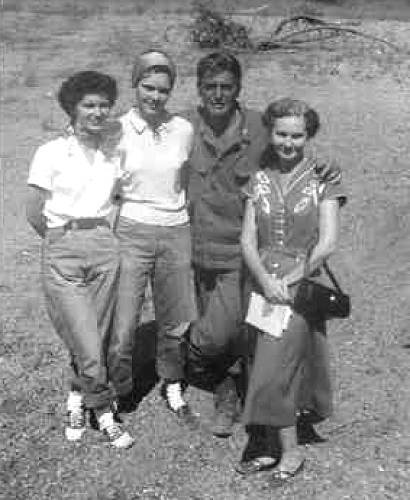
58 The Glory Brigade - Wanda and Mary Warren, Victor Mature and Eula Jenkins
One of my volunteer activities is as a member of the Tuscumbia Alumni Association committee which is chaired by Larry Flaugher. Our association is holding a fund raiser which Larry has named the “Pig and Pickle Fest” to be celebrated at the Tuscumbia Riverside Park Saturday, September 17, 11 am to 7 pm. Beneficiaries are Miller County Special Olympics, Tuscumbia Alumni Association, and the Village of Tuscumbia. Featured will be BBQ and fried dill pickles accompanied by great music and a car show. Here is the flier Larry designed for the occasion which gives more detail (flyer).

2011 Pig and Pickle Fest Flyer
Click image for larger view in PDF format
If you want to have a really good time plan to attend the event which I anticipate will be very enjoyable and fun.
That’s all for this week.
 Joe Pryor
Previous article links are in a dropdown menu at the top of all of the pages.
|

